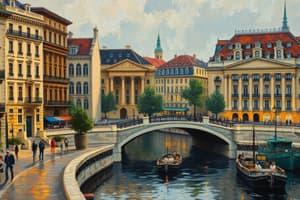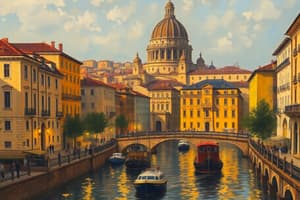Podcast
Questions and Answers
Flashcards
Vāstu-śāstra
Vāstu-śāstra
An ancient Indian architectural science that considers the influence of cosmic energy on buildings and their occupants.
Kāśyapa-śilpa
Kāśyapa-śilpa
A treatise focusing on temple architecture and iconography, outlining rules for constructing temples and creating deities.
Nārada-śilpa-śāstra
Nārada-śilpa-śāstra
A comprehensive text covering various aspects of town planning, including roads, water resources, different types of towns, fortifications, palaces, and temple architecture.
Viśvakarma-prakāśa
Viśvakarma-prakāśa
Signup and view all the flashcards
Mānasāra
Mānasāra
Signup and view all the flashcards
Kautilya's Fortified City
Kautilya's Fortified City
Signup and view all the flashcards
Town Planning
Town Planning
Signup and view all the flashcards
Architectural Legacy of India
Architectural Legacy of India
Signup and view all the flashcards
Śilpa-śāstra
Śilpa-śāstra
Signup and view all the flashcards
Padmaka
Padmaka
Signup and view all the flashcards
Svastika
Svastika
Signup and view all the flashcards
Prastara
Prastara
Signup and view all the flashcards
Kārmuka
Kārmuka
Signup and view all the flashcards
Caturmukha
Caturmukha
Signup and view all the flashcards
Daṇḍaka
Daṇḍaka
Signup and view all the flashcards
Sarvatobhadra
Sarvatobhadra
Signup and view all the flashcards
Kārmuka village location
Kārmuka village location
Signup and view all the flashcards
Cave Temples
Cave Temples
Signup and view all the flashcards
Draviḍian Temples
Draviḍian Temples
Signup and view all the flashcards
Thanjavur Temple
Thanjavur Temple
Signup and view all the flashcards
Padma-garbha-maṇḍala
Padma-garbha-maṇḍala
Signup and view all the flashcards
Vimāna
Vimāna
Signup and view all the flashcards
Śikhara
Śikhara
Signup and view all the flashcards
Konark Sun Temple
Konark Sun Temple
Signup and view all the flashcards
Study Notes
Architecture and Civil Engineering
- Vinayak Rajat Bhat is an Associate Professor at the Centre for Indian Knowledge Systems, Chanakya University, Bengaluru.
- The presentation deals with topics like bad drainage systems, town planning, temple architecture, and the importance of Indian Vastu tradition,
- India's IT capital, Bangalore, experiences flooding due to rapid growth and lack of proper planning.
- Mumbai's flooding issues are often attributed to human-made problems rather than the quantity of water.
- The presentation highlights cities in India facing issues with urban planning, safety, and overcrowding (e.g., Kanpur, Delhi, and Bangalore).
- Waterlogging is a common issue during rainy seasons across various Indian cities.
- Ancient Indian texts (like Kautilya's plan) show detailed urban planning, zoning based on Varna, and identification of areas for specific activities,
- Archaeological explorations confirm well-developed town planning in the Indus Valley Civilization.
- Archaeological excavations in India point to ancient town-planning practices.
- Over 3000 ancient monuments and archaeological sites in India demonstrate its architectural legacy.
- The presentation also discusses the importance of Indian Vastu traditions and their relevance to architecture.
- Vāstu-śāstra, also known as Vāstu-vidyā or śilpa-śāstra, deals with the science of artistic creation through design, fabrication, and construction.
- Key elements of Vāstu-śāstra include the earth/ground, temples/palaces, conveyance, and couches.
- Vāstu-śāstra principles include aligning structures with natural forces to optimize intended use.
- Different categories of towns (e.g., capital city, secondary residence of a king, commercial centers, fortifications) are explained in detail, including specific examples from Indian history.
- The presentation lists various alternative designs for town planning (like Dandaka, Nandyāvarta, Sarvatobhadra, and Prastara), mentioning their suitability for different contexts and geographic locations.
- Temple architecture's long history includes cave temples (e.g., Ajanta and Ellora), and specific South Indian temple styles (e.g., Chola and Pandya).
- The presentation covers famous examples of temples like Thanjavur Temple (a 1000-year-old granite structure), Sun Temple at Konark, and Kailāsa Temple in Ellora, emphasizing their construction details, and astronomical/timekeeping features.
- Structural components of temples, including Garbhagrha, Mandapa, and Prāhāra, and iconography are detailed.
- Various aspects of temple architecture in ancient India, including their components, types, number of stories, and shapes of the vimāna, are examined.
Town Planning and Architecture
- Town planning is a collective set of processes, ideas, and methods to deploy land for human habitation.
- It involves the design of land use, built environment, including air, water, and infrastructure, transportation, communication networks, and optimal layout of human settlements.
- Architecture deals with planning, designing, and constructing buildings like residential houses, common meeting places (shops, offices, temples), and other structures (dams, bridges, ports and transportation hubs).
Selected Vāstu-śāstra Texts
- Various texts (e.g., Kāśyapa-śilpa, Nārada-śilpa-śāstra, Viśvakarma–prakāśa, Mānasāra) cover issues related to town planning.
- Each text discusses different aspects of principles behind designing temples, residences, and town planning in India.
- These texts detail topics such as site selection, town design, land use patterns, and related issues.
Water Management
- Step wells are discussed as an example of water management in ancient India.
Iconography
- Idol making requires understanding the relative proportions of different body parts (e.g., eyes, ears, chin).
- Technical details on body proportions for idols of gods are detailed in ancient Indian texts.
Additional Information
- There is a list of issues discussed in Vāstu-śāstra, including Yajamāna (host), Sthāpatyam (architecture), Śilpis (craftspeople), and Bhūmi (land).
- The presentation also includes topics like Vāstospati (offerings), Pādavinyāsa (site layout), Vastu (materials) ,and Alankaraņam (renovations and decorations) in relation to construction.
- There are examples of four types of Sthāpati (master architects) and other technicians within the construction team.
Studying That Suits You
Use AI to generate personalized quizzes and flashcards to suit your learning preferences.





